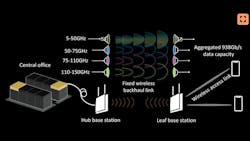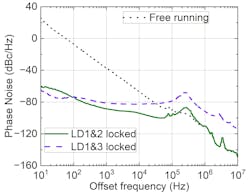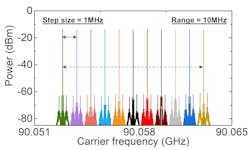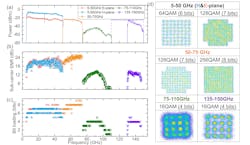Synced Wireless Electronic + Photonic Link Approaches 1-Tb/s Capacity
What you’ll learn:
- The challenge of achieving extremely high data rates via RF and optical links.
- How a hybrid RF/optical link was configured and deployed.
- The performance this hybrid link was able to provide.
Higher-speed wireless links for applications such next-generation radio-access-network (RAN) transmissions between base stations are seeking to achieve rates exceeding 100 Gb/s to connect access points and hubs. This has motivated researchers to explore how to better exploit the wireless spectrum from sub-6-GHz to millimeter-wave (mmWave), e.g., D-band up to 170 GHz, for data transmission, using either all-electronic or optoelectronic approaches.
However, these all-electronic and optoelectronic methods have been restricted to being used separately, due to the challenge of generating broadband signals with synchronized carrier frequencies. Addressing this gap, a team at University College London (UCL) developed and demonstrated an ultra-wide 145-GHz bandwidth wireless transmission of orthogonal frequency-division-multiplexing (OFDM) signals over the air, covering the 5- to 150-GHz frequency region.
They did this by combining the merits of high-speed electronics and microwave photonics technologies. The signals over the 5- to 75-GHz range are generated using high-speed digital-to-analog converters. The high-frequency mmWave band signals, including the 75- to 110-GHz portion of the W-band and 110- to 150-GHz swath of the D-band signals, are generated by mixing optically modulated signals with frequency-locked lasers on high-speed photodiodes.
Reaching 145-GHz Total Bandwidth via OFDM Plus Bit Loading
By frequency-locking two pairs of narrow linewidth lasers and referring them to a common, shared quartz oscillator, they were able to generate W- and D-band signals with stable carrier frequency and reduced phase noise compared to free-running lasers, thus maximizing the use of spectrum.
Using OFDM format and bit loading, they achieved a 938-Gb/s transmission data rate with less than 300-MHz gap between different RF and mmWave bands. The team maintains that this total bandwidth of 145 GHz is more than 5X higher than the previous wireless-transmission world record.
Despite that, quite a few demonstrations of mixers can convert baseband signals to desired mmWave frequency by mixing it with electrical local oscillator (LO). However, these typically suffer from high conversion loss, high noise figure, and limited modulation bandwidth. Further, the phase noise of a local oscillator scales as its frequency increases, which eventually limits spectrum efficiency.
Photonics and mmWave Signals
On the other hand, photonics technologies show great promise in mmWave signal generation. By combining a modulated optical signal with an unmodulated optical LO laser and detection using a high-bandwidth photodetector, the mmWave signal can be generated with a center frequency corresponding to the frequency difference between modulated signal and LO.
With this technique, researchers have generated and transmitted W- and D-band signals over the air. They demonstrated 125 Gb/s at the W-band in a single-in-single-out system and even 1.056 Tb/s via 24-GHz bandwidth using two pairs of dual polarization at D-band.
However, these demonstrations predominantly use free-running lasers for both signals and LO, which results in a drift of the carrier frequencies at a scale of tens of gigahertz due to thermal and aging reasons. This precludes the joint exploitation of both electronic- and photonic-assisted signal-generation methods in the generation and transmission of multiple, closely spaced frequency bands.
UCL Approach Merges Electronic and Photonic Methods
The UCL team used both electronic and photonic methods to demonstrate an over-the-air 145-GHz wireless ultrawideband transmission using a hybrid photonic-assisted and all-electronic transmission arrangement.
They accomplished this feat by combining three all-electronic channels spanning frequencies from 5 to 50 GHz and 50 to 75 GHz, with two photonic-assisted wireless channels, covering W-band (75 to 110 GHz) and D-band (110 to 150 GHz) (Fig. 1). By frequency locking two pairs of lasers, they generated W-band and D-band signals with precise frequencies that referred to the same reference source as the all-electronic channels.
Compared to demonstrations based on free-running lasers, their demonstrations using locked, narrow-linewidth signals significantly improved phase noise for signal generation with high spectral efficiency.
The frequency locking between lasers ensures minimum guard band between neighboring frequency bands, which is a key enabler for wireless super-channel transmission system. At the same time, the mutual frequency locking eliminates the need for an ultra-stable cavity used in conventional laser frequency-stabilization methods, reducing system size and power consumption.
Using these techniques, they achieved the 938-Gb/s performance through a 12-cm non-collimated point-to-point wireless link.
Test Results Reveal Greatly Improved Phase Noise
The measured phase noise of the carrier signals as generated comes via the frequency-locked LD1-LD2 laser-diode pairs (green solid curve) and LD1-LD3 pair (purple dashed curve) (Fig. 2). The black dotted curve shows the LD1-LD2 beat when the lasers are free-running. By comparing the black dotted and green solid curves, locked lasers show significant improvement of phase noise within the locking bandwidth (e.g., 50 dB improvement at 1 kHz).
Similarly, Figure 3 shows the measured RF spectrum of a 90-GHz carrier generated using the locked LD1-LD2, at a resolution bandwidth of just 100 Hz. By fine-tuning the wavelength of LD2, they were able to flexibly tune the carrier frequency at a small step of 1 MHz while still maintaining the laser locking and thus the low-noise RF carrier.
The measured power spectrum of the received signals at a resolution of 100 MHz shows the received 5-50-GHz, H-plane, E-plane, 50- to 75-GHz, 75- to 110-GHz, and 135- to 150-GHz signals in blue, pink, orange, green and purple solid curves, respectively (Fig. 4).
Note that the transmitted signal in D-band spans over the whole 110- to 150-GHz region, as shown by the dashed purple line. For the five 50-GHz signals, the measured H-plane signal has 10-dB higher power than the E-plane signal due to the higher receiver RF amplifier gain.
Nevertheless, their signal-to-noise ratios (SNRs) are similar, with an average SNR of 20.6 dB. This indicates that the signal quality is limited by the receiver’s electronic noise. The V-band signal at 50 to 75 GHz shows a higher SNR, with an average SNR of 23.3 dB due to the higher antenna gain.
The variation of signal power at different frequencies is due to the combined frequency response of the digital-to-analog converters (DACs), the RF cables, and the antennas. The W- and D-band signals have an SNR of about 14 dB due to the relatively low transmitter-amplification gain and the higher link loss.
Their work is detailed in the paper “938 Gb/s, 5-150GHz Ultra-Wideband Transmission Over the Air Using Combined Electronic and Photonic-assisted Signal Generation,” published in the IEEE Journal of Lightwave Technology. While that paper is behind a paywall, it’s also posted here at the UCL web site.




